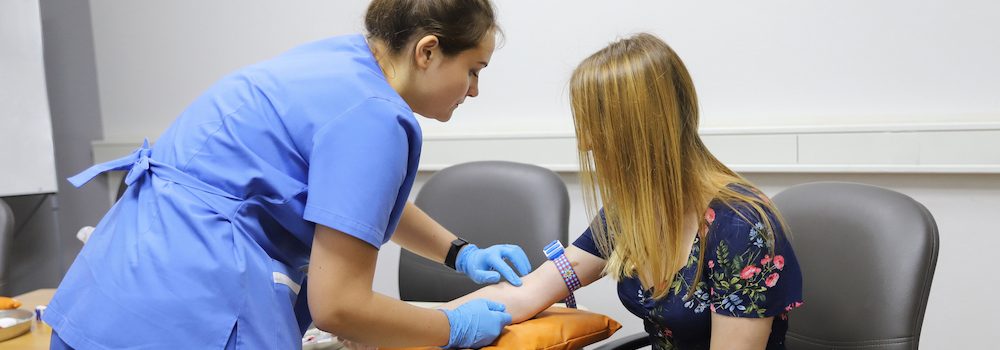Rumored Buzz on Northeast Medical Institute - New Haven Campus Phlebotomy Course & Cna Class
Rumored Buzz on Northeast Medical Institute - New Haven Campus Phlebotomy Course & Cna Class
Blog Article
About Northeast Medical Institute - New Haven Campus Phlebotomy Course & Cna Class
Table of ContentsThe Of Northeast Medical Institute - New Haven Campus Phlebotomy Course & Cna ClassNortheast Medical Institute - New Haven Campus Phlebotomy Course & Cna Class Fundamentals ExplainedWhat Does Northeast Medical Institute - New Haven Campus Phlebotomy Course & Cna Class Mean?4 Easy Facts About Northeast Medical Institute - New Haven Campus Phlebotomy Course & Cna Class Shown3 Easy Facts About Northeast Medical Institute - New Haven Campus Phlebotomy Course & Cna Class ShownSome Of Northeast Medical Institute - New Haven Campus Phlebotomy Course & Cna Class
Nonetheless, the usage of such tools ought to be accompanied by other infection avoidance and control practices, and training in their usage. Not all security tools apply to phlebotomy. Before selecting a safety-engineered gadget, users must completely check out offered devices to determine their ideal use, compatibility with existing phlebotomy practices, and efficiency in safeguarding staff and individuals (12, 33).For settings with reduced resources, expense is a driving consider purchase of safety-engineered tools - CNA Classes. Where safety-engineered tools are not readily available, competent use of a needle and syringe serves. Unintended direct exposure and particular information regarding a case should be videotaped in a register. Assistance services ought to be advertised for those that undergo unintentional direct exposure.
In the blood-sampling room for an outpatient division or clinic, give a comfortable reclining couch with an arm rest.
The Single Strategy To Use For Northeast Medical Institute - New Haven Campus Phlebotomy Course & Cna Class
Make certain that the indications for blood sampling are clearly defined, either in a composed protocol or in recorded instructions (e.g. in a lab type). Accumulate all the equipment needed for the procedure and location it within safe and very easy reach on a tray or cart, making sure that all the things are clearly noticeable.
Present on your own to the patient, and ask the individual to mention their full name. Examine that the research laboratory form matches the patient's identity (i.e. match the patient's details with the research laboratory type, to make certain accurate recognition).
Make the individual comfortable in a supine placement (if feasible). Place a clean paper or towel under the person's arm. Talk about the examination to be carried out (see Annex F) and get spoken permission. The patient has a right to reject a test any time before the blood sampling, so it is very important to guarantee that the patient has understood the procedure.
Indicators on Northeast Medical Institute - New Haven Campus Phlebotomy Course & Cna Class You Should Know
Prolong the client's arm and inspect the antecubital fossa or forearm. Locate a blood vessel of a good dimension that is visible, straight and clear. The diagram in Area 2.3, reveals common settings of the vessels, however several variants are feasible. The average cubital blood vessel lies between muscle mass and is usually one of the most very easy to penetrate.
DO NOT insert the needle where veins are drawing away, because this boosts the opportunity of a haematoma. The vein needs to show up without applying the tourniquet. Finding the capillary will assist in identifying the proper dimension of needle. Apply the tourniquet regarding 45 finger sizes over the venepuncture website and re-examine the capillary.
Haemolysis, contamination and presence of intravenous fluid and medication can all alter the results (39. Nursing team and medical professionals may access central venous lines for specimens adhering to methods. Nevertheless, specimens from central lines lug a threat of contamination or erroneous laboratory test outcomes (https://www.tumblr.com/northeastmed/754571099590852608/earn-your-phlebotomy-certification-at-northeast?source=share). It serves, yet not perfect, to injure samplings when very first introducing an in-dwelling venous device, before attaching the cannula to the intravenous fluids.
An Unbiased View of Northeast Medical Institute - New Haven Campus Phlebotomy Course & Cna Class
Allow the location to dry. Failure to permit enough call time increases the danger of contamination. DO NOT touch the cleaned up website; in specific, DO NOT position a finger over the blood vessel to direct the shaft of the subjected this post needle. It the website is touched, repeat the sanitation. Execute venepuncture as follows.
Ask the individual to develop a hand so the blood vessels are extra prominent. Get in the blood vessel promptly at a 30 level angle or much less, and proceed to present the needle along the blood vessel at the most convenient angle of entry - PCT Training. When adequate blood has been accumulated, release the tourniquet BEFORE taking out the needle
See This Report on Northeast Medical Institute - New Haven Campus Phlebotomy Course & Cna Class
Withdraw the needle delicately and use mild pressure to the website with a clean gauze or completely dry cotton-wool ball. Ask the individual to hold the gauze or cotton wool in place, with the arm expanded and increased. Ask the patient NOT to flex the arm, because doing so causes a haematoma.

An Unbiased View of Northeast Medical Institute - New Haven Campus Phlebotomy Course & Cna Class
Do not push the syringe plunger since added stress enhances the danger of haemolysis. Where feasible, keep the tubes in a shelf and relocate the shelf towards you. Inject downwards right into the appropriate coloured stopper. DO NOT remove the stopper because it will certainly release the vacuum cleaner. If the sample tube does not have a rubber stopper, infuse incredibly slowly into television as reducing the stress and rate utilized to transfer the specimen decreases the danger of haemolysis.

Report this page